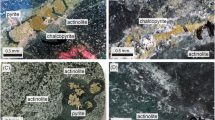Abstract
The formation of many metallic and non-metallic ore deposits is a result of coupling of mineralization, related to anoxic environment and regional, or global background. Inter act~on, concordance and continual development of the mineralization and environmental background control the large to superlarge scale of ore deposits. Three kinds of ore-forming models related to anoxic environment and three important background patterns are suggested. The turning period of geological history is favorable to the formation of large to superlarge ore deposits.
Similar content being viewed by others
References
Cluff, R. M., Paleoenvironment of the new Albany Shale Group (Devonian-Mississippian) of Illinois,Jour. of Sed. Petrology, 1980, 50(30): 767.
Fan Delian, Yang Xiuzhen, Wang Lianfang et al., Petrological and geochemical characteristics of a nickel-molybdenum-multielement- bearing Lower Cambrian black shale from a certain district in South China,Geochimica (in Chinese with English abstract), 1973, (3): 143.
Arthur, M. A., Schlanger, S. O., Cretaceous “Oceanic Anoxic Events” as causal factor in development of reef-reservoired giant oil fields,AAPG Bull., 1979, (63): 870.
Leggett, J. K., British Lower Paleozoic black shales and their paleooceanographic significance,Jour. Geol. Soc. London, 1980, 137(2): 139.
Jenkyns, H. C., Cretaceous anoxic events: from continents to oceans,Jour. Geol. Soc. London, 1980, 137(2): 171.
Cook, P. J. Shergold, J. H., Phosphorus, phosphorite and skeletal evolution at the Precambrian-Cambrian boundary,Nature, 1984, 308: 231.
Cook, P. J., Shergold, J. H., Proterozoic and Cambrian phosphorite-nature and origins,Phosphate Deposits of the World, V. 1,Proterozoic and Cambrian Phosphorite, Cambridge: Cambridge Universitv Press, 1986, 369–386.
Donnelly, T. H., Shergold, J. H., Southgate, P. N. et al., Events leading to global phosphogenesis around the Proterozoic/ Cambrian boundary,Phosphorite Research and Development, Geol. Soc. Spec. Publ., 1990, (52): 273.
Brasier, M. D., Phosphogenic events and skeletal preservation across the Precambrian-Cambrian boundary interval,Phosphorite Research and Development, Geol. Soc. Spec. Publ., 1990, (52): 289.
Goodfellow, W. D., Anoxic stratified ocean as a source of sulphur in sediment-hosted stratiform Zn-Pb deposits (Selwyn Basin, Yukon, Canada),Chemical Geology (Isotope Geoscience Section), 1987, 65: 359.
Jenkyns, H. C., Geczy, B., Marshall, J. D., Jurassic manganese carbonates of Central Europe and Early Toarcian Anoxic event,Jour-. of Geology, 1991, 99(2): 137.
Compton, J. S., Hodell, D. A., Arrido, J. R., Origin and age of phosphorites from the south-central Florida platform: Relation of phosphogenesis to sealevel fluctuations and6 13C excursion,Geochim. et Cosmochim. Acta, 1993, 57(1): 131.
Fan Delian, Ye Jie, Wang Zhongcheng et al., The anoxic environment and mineralization, inAdvances in Geosciences (I),Contributions to 28th IGC., Washington, D. C., Beijing: China Ocean Press, 1989, 164–174.
Fan Delian, Ye Jie, Liu Tiebing, Black shale series hosted silver vanadium deposits of the Upper Sinian Doushantuo Formation, western Hubei Province, China,Explo. Mining Geol., 1992, l (1): 29.
Tu Guangzhi et al.,Geochemistry of Stratabound Ore Deposits in China (in Chinese), Vol. 3, Beijing: Science Press, 1988, 388.
Han, Fa, Hutchinson, R. W., Evidence for exhalative origin for rocks and ores of the Dachang tin polymetallic ore field-- the ore-bearing formation and hydrothermal exhalative sedimentary rocks,Mineral Deposits (in Chinese), 1989, (2): 25.
Fan Delian, Liu Tiebing, Ye Jie, The process of formation of manganese carbonate deposits hosted in black shale series,Econ. Geol., 1992, 87: 1419.
Fan Delian, Ye Jie, Wang Zhongcheng et al., Anoxic environment and ore formation,Initiation. Innovation and Strivention (in Chinese), Chongqing: The Chongqing Branch of China Science and Technology Reference Press, 1990, 45–83.
Bureau of Geology and Mineral Resources of Guangxi Zhuang Autonomous Region,The Sedimentary Facies, Palawgeography and Relatively Mineral Deposits of Devonian in Guangxi (in Chinese), Nanning: Guangxi People’s Publishing House, 1987, 292.
Huang Ruihua, Du Fangquan, Wang Fuquan et al.,Tin Tectono-georhemistry in South-East Part of China (in Chinese), Beijing: Science Press. 1989, 203.
Chen Daizhao, Chen Qiying, Framework of sequence stratigraphy and sea level change of Early-Middle Devonian in South Guizhou Province,Science in China (in Chinese), Ser. B, 1994, 24 (11): 1197.
Bureau of Geology and Mineral Resources of Guangxi Zhuang Autonomous Region,Devonian of Guangcri (in Chinese with English abstract), Wuhan: China University of Geosciences Press, 1992, 384.
Wang Hongzhen, Wang Ziqiang, Zhang Linghua et al.,Tectonic Ewlution of the Mesoproterozoic, Neoproterozoic and Palaeozoic Continental Margins of China (in Chinese). Beijing: Geological Publishing House, 1994, 213.
Zhang Wentang, Early Cambrian Chengjaing fauna and its trilobites,Acta Palaeontologica Sinica (in Chinese with English abstract), 1987, 26(3): 223.
Chen Junyuan, Hou Xianguang, Lu Haoshi, Early Cambrian netted scale-bearing worm-like sea animal,Acta Palaeontologica Sinica (in Chinese with English abstract), 1989, 28 (1): 1.
Ye Lianjun.The Phosphorites of China (in Chinese), Beijing: Science Press, 1989, 339.
Fan Delian, Yang Ruiying, Huang Zhongxiang, The Lower Cambrian black shale series and the iridium anomaly in South China,Developments in Geoscience, Contribution to 27th IGC, Moscow, Beijing: Science Press, 1984, 215–224.
Hsü, K. J., Oberhansli. H., Gao Jiyuan et al., Strangelove ocean before the Cambrian exolosion.Scientia Geolonica Sinica (in Chinese with English abstract), 1986, (1): 1.
Author information
Authors and Affiliations
Additional information
Project supported by the National Climbing Program of China 1A30).
Rights and permissions
About this article
Cite this article
Fan, D., Zhang, T. & Ye, J. Anoxic environment and formation of superlarge ore deposits. Sci. China Ser. D-Earth Sci. 41 (Suppl 1), 37–46 (1998). https://doi.org/10.1007/BF02875636
Received:
Issue Date:
DOI: https://doi.org/10.1007/BF02875636




